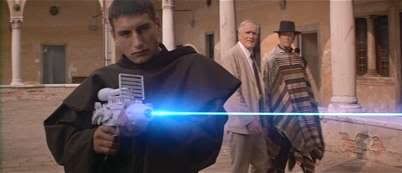Laser gun with a pyrotechnic lamp. Developed in 1984.
A memorial of science and technology, 1st category (certificate #488)
Authors:
- Honored scientist and technician of the R.S.F.S.R, technical sciences PhD, prof., general-major Sulakvelidze Victor Samsonovich (grad. 1943) - project director
- technical sciences PhD, prof. Duvanov Boris Nikolaevich (grad. 1966) - technical and experimental work
- scientific ass. captain Gorev Victor Vladimirovich - technical and experimental work
- Avakiants Lyudmila Igorevna
Autor certificate #224424 of the State Commitee for inventions and scientific breakthroughs of the USSR.
Construction of the gun - NIL-4 technician Simonov A.V.
Developed in the Russian Nuclear Strategic Forces Academy (RVSNA) of Peter the Great.
Boris DUVANOV, technical sciences PhD, prof.
Mikhail PAVLUSHENKO, science ass.
In the 1970s many countries, foremost the USSR and the US began developing powerful laser installations - both peaceful and military purpose. Bulky, they were fitted with solid support structures, very complex registering and computing apparates. However, the situation at the time required small guns to be developed as well. The development of "inspector satellites" - which approached enemy space objects to investigate them - pushed us forward. The cosmonauts required personal arms for watching their space stations. Usual weapons weren't good, since the recoil would've offset both the shooter and the space object. A laser was far better. In space, it's beam could blind the sensitive sensor equipment of enemy machinery, burn through the cloth of enemy space suits.
The works on the Soviet individual laser weapon were made under the leadership of one of the academy facultees, professor, technical sciences PhD general-major V.S. Sulakvelidze. Theoretical and experimental investigation was done by one of the authors of this article. The construction of the gun was developed by science ass. A.V. Simonov, test firings were made by adjunct V.V. Gorev. As you all know any laser includes the active material, the source of charge and the resonator. At first we choose yttrium-aluminum granate crystal as active material, which generated an infra-red beam with a relatively low generation demand. The powdered ends of the crystal served as resonator. For optical charging we chose a compact gas lamp, similar to the one photoreporters use on their cameras but with far greater energy output. Because even the most compact power source weighed 3-5 kg. it had to be placed separate from the gun.
At the same time we were looking for new active materials. The constructors preferred optical thread elements - they, like the yttrium-aluminum granate, had neodim ions initiated by the energy input. Because the diameter of such a thread was around 30 mkm, and the surface of the large thread woven from smaller ones (300 to 1000 threads combined) was large, the generation barrier (the minimum required charge energy) was lower, and resonators weren't needed.
During the tests we explored the energy and space-consuming characteristincs of various crystals and active threads with various lengths of thread, their work in impulse, amplitude and continous firing modes. During this our work became very interesting to other organizations. The Ministry of Defense cinema department even made an educational movie in the laboratory "Dangerous beam" which detailed our achievements.
In the second phase of developent we started making a gun which would be identical by mass and size to a general bullet handgun. For this we needed a small charge source, to be put in like an ammo cartridge. For this, we decided to use expendable pyrotechnic powerful lamps, which were filled with oxygen and metal fold or powder. Lighted up by an electric discharge, it burns out in 5-10 milliseconds, under the temperature of around 5000 Kelvin (remember engineer Garin's hyperboloid from sci-fi?). Of course all components had to be non-toxic and safe from accidental selfdetonation. Despite the "blaze" being ordinary, it's output had to be increased 5-10 times. The variants were made, and we chose a zirkonium thin-fold instead of commonly used magnium, which increased per unit light output 3 times, with metal salt additives, which "corrected" the lamp's light output closer to the consuming specter of the active element.
We must note that all experimental works were made by our own hands. First self-made lamps were small cylinders 1cm in diameter, with a wolfram-renium thread inside, covered with burning paste to light up the pyrotechnic mix (zirkonium in oxygen). The cylinder itself was rounded by an active material thread in sturdy package. In later constructions we used hollow pyrotechnic lamps with external and internal threading of active elements, which increased the charge effectiveness.
And so our academy achieved important results. One of the enterprises alraedy prepared a serial production line to develop lamps, but the government started conversion of defense industry. The line was cut, but the development continued inertially until the handmade lamps ran out.
Now the museum of the academy stores a laser revolver and handgun. The first has an yttrium-aluminum granate crystal and an optical thread active element in the barrel, and the cylinder is fitted with six "ammo" pieces - pyrotechnic lamps. After a shot it revolves, putting another lamp into the lighting chamber, and to light it up it uses an electric "Krona"-type battery fitted in the gun handle.
What concerns the gun, the lamps are in the cartridge. After each shot they're thrown out like shells, and the next is put into the lighting chamber. We also prepared a third variant, a combined gun. Inside the hollow lamp - a crystal threaded by active optical elements, and it's packed in a lightning device with selective cover. An optical trigger can be used to choose joint or separate "firing" of the crystal and the active thread. To increase the charge effctiveness we covered the thread with a material that cuts part of the light into neodim ion consumption spectre and cuts off the ultraviolet rays harmful for the glass.

 "
"